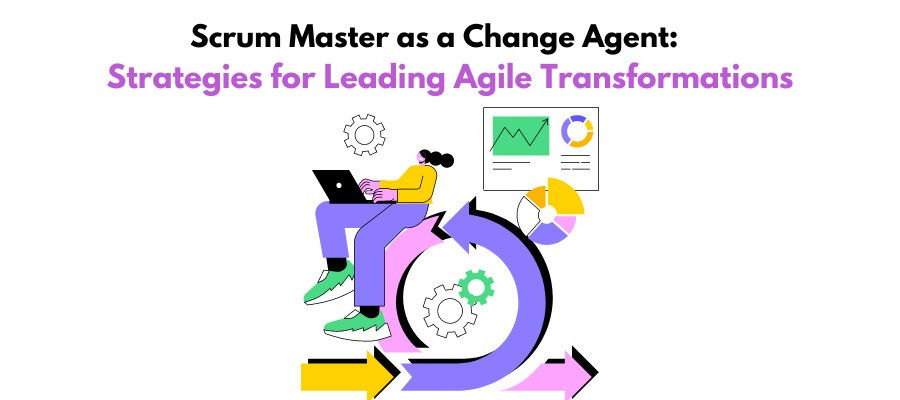Scrum Master as a Change Agent: Strategies for Leading Agile Transformations

The role and responsibilities of a Scrum Master are diverse and require a wide range of skills and expertise. A competent Scrum Master should understand various tools and techniques and know when and how to apply them based on the situation and context. The primary goal of a Scrum Master is to facilitate the adoption and implementation of the Scrum framework, enabling individuals and teams to understand and embrace its core principles.
The Scrum Master is crucial in driving change by leading the Scrum team to achieve greater productivity and deliver high-quality products. To achieve this, a Scrum Master must be proactive in identifying and implementing changes, ranging from simple modifications to complex structural alterations, that will enhance the effectiveness of the Scrum team. These changes may include acquiring specialized expertise for a project or improving the workspace environment to boost team morale and performance.
Scrum Master as a change agent
A change leader is an expert who plays a crucial role in organizational transformation by prioritizing the efficiency, growth, and development of the organization. In essence, a change leader acts as a driving force for change. Leading change is a demanding task that requires significant time and effort, and it is often undervalued. However, Scrum Masters must possess this essential skill not only to initiate change but also to educate others on how to become effective "change agents."
As the leader of a Scrum Team, the Scrum Master is responsible for promoting a Scrum-friendly mindset within the organization. Luckily, the Scrum Master is in an advantageous position to steer the company towards creating an environment that facilitates the growth of the Scrum Team.
With their understanding of what needs to be changed and why change is essential, the Scrum Master can bring about change from within. Additionally, the Scrum Master can encourage collaboration and facilitate discussions among different Scrum Teams. Working with various departments such as HR, Finance, and Sales is crucial for a Scrum Master.
Since the Scrum Master is knowledgeable about the workings of their Scrum Team, they should exhibit leadership qualities and influence the organizational system. By collaborating with other Scrum Masters, they can drive necessary organizational changes, thus being viewed as a change leader from the Scrum Team's perspective.
Strategies for leading Agile transformations
Driving change is challenging and time-consuming, but SMs need to possess this skill and teach others how to become change agents. To lead change effectively, there are six main steps to follow.
Step 1: Identify the need for change using the Golden Circle Model 'Why, How, What.’ Determine the reason for the change, why it is crucial for the organization, and what you can change. Also, please focus on the 20% of causes with 80% of the effects, register all opportunities for change, and review them with stakeholders.
Step 2: Create a team of supporters and identify the victim and critic type of people. Form a coalition of supporters and influencers and include skeptical people in all discussions. Lead the change through other people, and use change agents like scrum master and steering committee.
Step 3: Highlight the benefits, reasons, and challenges of driving change. Present a transparent view of all advantages and disadvantages of the current and future process, show the simulation of benefits and savings from the difference, and use the Subject Matter Expert and Informal Leaders to support the need for change.
Step 4: Implement the change by engaging people, starting small, acting fast, and running experiments. Transition in the difference, show enthusiasm and be patient and determined to drive the change. Give regular updates about the progress, challenges, and significant milestones.
Step 5: Finalize the implementation of the change by sharing a summary of what has been changed and its impact on the organization. Act immediately when any obstacles occur to limit negative impact.
Step 6: Monitor change by organizing review sessions to highlight benefits and determine what can be improved with the new process. Be a guardian of the new process/mechanism so the organization can fully adopt the new behaviors.
Driving change is an essential skill for SMs, and to lead change effectively, one must follow these six main steps.
Conclusion
The role of a Scrum Master as a change agent is crucial in leading Agile transformations within an organization. Scrum Masters must possess essential skills such as identifying the need for change, creating a team of supporters, highlighting the benefits and challenges, implementing the change, finalizing the implementation, and monitoring change.
By being proactive and implementing changes, a Scrum Master can drive organizational growth and development. With a Scrum-friendly mindset and collaborative efforts, Scrum Masters can influence the administrative system and lead change from within, thus being viewed as change leaders from the Scrum Team's perspective.
Reference
- https://www.scrum.org/resources/blog/scrum-master-change-agent?gclid=Cj0KCQjwuLShBhC_ARIsAFod4fLhDyEKxLNO9xOFEl5j4rUgrRax0K1zVgSKWFf7HHtl4-RhOOvBHD0aAjtxEALw_wcB



